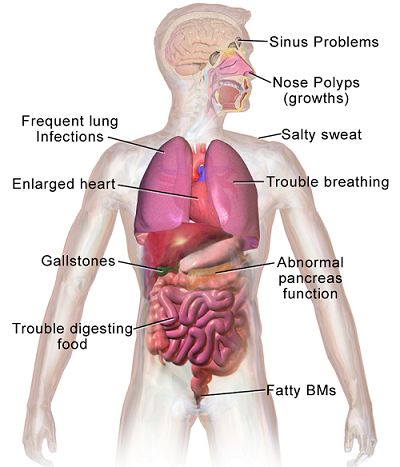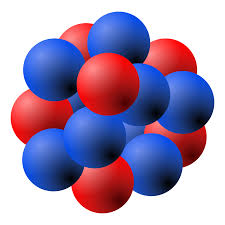Learning Objectives
- Learn about Chloride's role in fluid balance
Chloride is the primary anion in extracellular fluid. In addition to passively following sodium, chloride has its own protein channels that reside in cell membranes. These protein channels are especially abundant in the gastrointestinal tract, pancreas, and lungs.
Chloride’s Role in Fluid Balance and Balancing pH
Chloride aids in fluid balance mainly because it follows sodium in order to maintain charge neutrality. Chloride channels also play a role in regulating fluid secretion, such as pancreatic juice into the small intestine and the flow of water into mucus. Fluid secretion and mucus are important for many of life’s processes. Their importance is exemplified in the signs and symptoms of the genetic disease, cystic fibrosis (CF).
Cystic Fibrosis
Cystic fibrosis is one of the most prevalent inherited diseases in people of European descent. It is caused by a mutation in a protein that transports chloride ions out of the cell. CF’s signs and symptoms include salty skin, poor digestion and absorption (leading to poor growth), sticky mucus accumulation in the lungs (causing increased susceptibility to respiratory infections), liver damage, and infertility.

Health problems associated with cystic fibrosis. (CC BY 3.0; Blausen.com staff (2014). "Medical gallery of Blausen Medical 2014". WikiJournal of Medicine 1 (2).DOI:10.15347/wjm/2014.010. ISSN 2002-4436.)
Chloride has several other functions in the body, most importantly in acid-base balance. Blood pH is maintained in a narrow range and the number of positively charged substances is equal to the number of negatively charged substances. Proteins, such as albumin, as well as bicarbonate ions and chloride ions, are negatively charged and aid in maintaining blood pH. Hydrochloric acid (a gastric acid composed of chlorine and hydrogen) aids in digestion and also prevents the growth of unwanted microbes in the stomach. Immune-system cells require chloride, and red blood cells use chloride anions to remove carbon dioxide from the body.
Low dietary intake of chloride and more often diarrhea can cause low blood levels of chloride. Symptoms typically are similar to those of hyponatremia and include weakness, nausea, and headache. Excess chloride in the blood is rare with no characteristic signs or symptoms.
Needs and Dietary Sources of Chloride
Most chloride in the diet comes from salt. (Salt is 60 percent chloride.) A teaspoon of salt equals 5,600 milligrams, with each teaspoon of salt containing 3,400 milligrams of chloride and 2,200 milligrams of sodium. The chloride AI for adults, set by the IOM, is 2,300 milligrams. Therefore just ⅔ teaspoon of table salt per day is sufficient for chloride as well as sodium. The AIs for other age groups are listed in Table \(\PageIndex{1}\).
Table \(\PageIndex{1}\): Adequate Intakes for Chloride.
| Age Group |
mg/day |
| Infants (0–6 months) |
180 |
| Infants (6–12 months) |
570 |
| Children (1–3 years) |
1,500 |
| Children (4–8 years) |
1,900 |
| Children (9–13 years) |
2,300 |
| Adolescents (14–18 years) |
2,300 |
| Adults (19–50 years) |
2,300 |
| Adults (51–70 years) |
2,000 |
| Adults (> 70 years) |
1,800 |
Source: Dietary Reference Intakes: Water, Potassium, Sodium, Chloride, and Sulfate. Institute of Medicine. www.iom.edu/Reports/2004/Diet...d-Sulfate.aspx. Updated February 11, 2004. Accessed September 22, 2017.
Other Dietary Sources of Chloride
Chloride has dietary sources other than table salt, namely as another form of salt—potassium chloride. Dietary sources of chloride are: all foods containing sodium chloride, as well as tomatoes, lettuce, olives, celery, rye, whole-grain foods, and seafood. Although many salt substitutes are sodium-free, they may still contain chloride.
Bioavailability
Bioavailability refers to the amount of a particular nutrient in foods that is actually absorbed in the intestine and not eliminated in the urine or feces. Simply put, the bioavailability of chloride is the amount that is on hand to perform its biological functions. In the small intestine, the elements of sodium chloride split into sodium cations and chloride anions. Chloride follows the sodium ion into intestinal cells passively, making chloride absorption quite efficient. When chloride exists as a potassium salt, it is also well absorbed. Other mineral salts, such as magnesium chloride, are not absorbed as well, but bioavailability still remains high.
Contributors and Attributions



